

7 reasons to leave them to their own devices. BYOD isn’t a recommendation, it’s a realty.

Everyone’s bought one and everyone uses one and everyone carries it around with them. When we organise a meeting or conference, we don’t send people an email telling them what device to bring, neither do we buy or lease a whole load of computers and hand them out. GearED. School Library Thrives After Ditching Print Collection. Home. SOUL BIOGRAPHIES Can Google Help Students Master the Art of Online Search? There’s been ample discussion in K–12 classrooms recently about the quality, or lack thereof, of students’ online research skills.
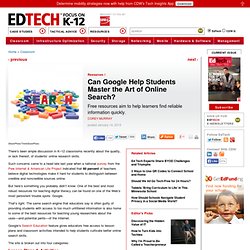
Such concerns came to a head late last year when a national survey from the Pew Internet & American Life Project indicated that 60 percent of teachers believe digital technologies make it hard for students to distinguish between credible and noncredible sources online. But here’s something you probably didn’t know: One of the best and most robust resources for teaching digital literacy can be found on one of the Web’s most persistent trouble spots: Google. That’s right. The same search engine that educators say is often guilty of providing students with access to too much unfiltered information is also home to some of the best resources for teaching young researchers about the uses—and potential perils—of the Internet.
The site is broken out into four categories: Lesson Plans & Activities. Poor ranking on international tests misleading about U.S. performance, new report finds. Socioeconomic inequality among U.S. students skews international comparisons of test scores, finds a new report released today by the Stanford Graduate School of Education and the Economic Policy Institute.
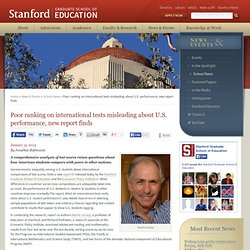
When differences in countries' social class compositions are adequately taken into account, the performance of U.S. students in relation to students in other countries improves markedly.The report, What do international tests really show about U.S. student performance? , also details how errors in selecting sample populations of test-takers and arbitrary choices regarding test content contribute to results that appear to show U.S. students lagging. Based on their analysis, the co-authors found that average U.S. scores in reading and math on the PISA are low partly because a disproportionately greater share of U.S. students comes from disadvantaged social class groups, whose performance is relatively low in every country.
The Learning Network - The Learning Network Blog - NYTimes.com. We need more access to A.P. classes to boost college degrees. By Gregg Fleisher In the 2010-2011 school year, approximately 903,630 U.S. public school graduates took at least one Advanced Placement exam and 540,619 achieved a passing score of 3 or higher, according the College Board.
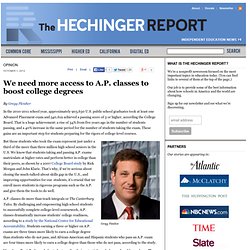
Courses - Global Online Academy. Register now for a Global Online Academy Summer Mini-Course!
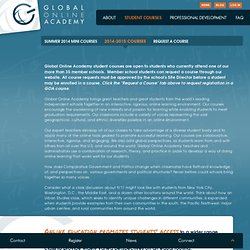
2-Week Courses offered June 16-27 This summer Global Online Academy will be offering 4 exciting new mini-courses. From yoga to journalism, these classes are designed to allow students to try new experiences in a supported, enriching, and low-stakes environment. In each mini-course, which run for two weeks, from June 16 - 27, students will: Work alongside peers from different schools Get 1-1 support and instruction from an expert teacher Develop new skills in a field of their choosing Spend 1-2 hours per day, 4-5 days per week learning and developing these skills. SAT® Report: Only 43 Percent of 2012 College-Bound Seniors Are College Ready. First, We Need a Brand New K–12 System. Digital learning is more than the latest addition to education reformers’ to-do lists, filed along with teacher evaluations, charter schools, tenure reform, academic standards, and all the rest.

A National Report Card - Nicole Allan. Graphics by Kiss Me I'm Polish Download this spread as a PDF More Money, More Problems?
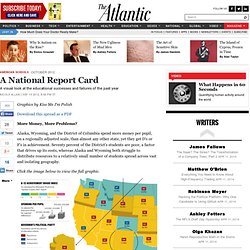
Alaska, Wyoming, and the District of Columbia spend more money per pupil, on a regionally adjusted scale, than almost any other state, yet they get D's or F's in achievement. Seventy percent of the District's students are poor, a factor that drives up its costs, whereas Alaska and Wyoming both struggle to distribute resources to a relatively small number of students spread across vast and isolating geography. Click the image below to view the full graphic. The Case of New Mexico In 2011, researchers at the Center for American Progress calculated educational return on educational investment (ROI), district by district. Technology Is Changing How Students Learn, Teachers Say.
The disruption of education: How technology is helping students teach themselves. Rigor Is Better. Last week the National Center for Education Statistics released the latest High School Transcript Study, which presents information from transcripts collected from a nationally representative sample of more than 37,000 high school graduates from more than 700 public and private schools.
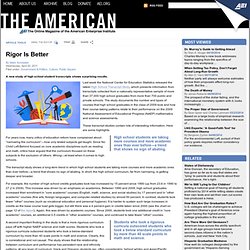
The study documents the number and types of courses that high school graduates in the class of 2009 took and how their course-taking patterns relate to their performance on the 2009 National Assessment of Educational Progress (NAEP) mathematics and science assessments. These transcript studies contain lots of interesting information. Districts Require E-Courses for Graduation.